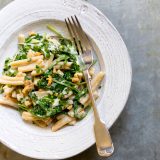Creamy pasta sauces pose two problems: They are finicky to make and they quickly decompose into a stringy or grainy mess. So when we came across a recipe from Nigel Slater that suggested using fresh goat cheese instead of the Parmesan called for in classic Alfredo and carbonara, we were intrigued.
The notion was simple. The heat of freshly cooked pasta and a splash of its cooking water would dissolve the soft chevre, making a rich, smooth sauce in no time. Except it didn’t work. The ingredients quickly broke down into a chalky mess. Then we discovered a technique by Marcella Hazan in which you first mix the cheese with olive oil.
It worked wonderfully, but why? Turns out, goat’s milk has more fat than cow’s milk, so turning it into cheese requires the addition of acid. The acid forms the cheese curds but also creates strong water-insoluble bonds between the proteins. Hence our chalky mess. But add oil to the chevre and those bonds slip apart and the cheese melts easily. The same trick works for any acid-set cheese, such as ricotta, cottage and feta.




